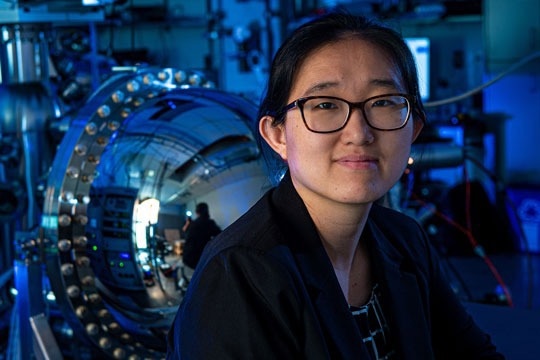The revelation in 2022 that electrons in magnetic iron-germanium crystals could spontaneously and collectively arrange their charges into a pattern with a standing wave astounded physicists. Magnetism is also produced by the collective self-organization of electron spins into ordered patterns, which seldom coexist with the patterns that form the standing wave of electrons known as a charge density wave by physicists.

Ming Yi. Image Credit: Jeff Fitlow/Rice University
Ming Yi and Pengcheng Dai of Rice University and many of their 2022 study collaborators presented a plethora of experimental evidence in a study that was published in Nature Physics. This demonstrates how rare the charge density wave discovery they made was—one in which the magnetic and electronic orders do not just coexist but are directly linked.
We found magnetism subtly modifies the landscape of electron energy states in the material in a way that both promotes and prepares for the formation of the charge density wave.
Ming Yi, Study Co-Corresponding Author and Assistant Professor, Physics and Astronomy, Rice University
More than a dozen researchers from Rice, the University of Washington, the University of California, Berkeley, Israel’s Weizmann Institute of Science, the Lawrence Berkeley National Laboratory (LBNL), Oak Ridge National Laboratory (ORNL), SLAC National Accelerator Laboratory, the Southern University of Science and Technology in China, and Oak Ridge National Laboratory (ORNL) contributed to the study.
The iron-germanium materials are Kagome lattice crystals, an extensively researched family of materials with 2D atom configurations resembling the weaving of traditional Japanese Kagome baskets, which have equilateral triangles that connect at the corners.
Yi added, “Kagome materials have taken the quantum materials world by storm recently. The cool thing about this structure is that the geometry imposes interesting quantum constraints on the way the electrons are allowed to zoom around, somewhat analogous to how traffic roundabouts affect the flow of traffic and sometimes bring it to a stop.”
Electrons naturally steer clear of one another. They do this, among other ways, by arranging their magnetic states or spins that point up or down in the opposite direction from those of their neighbors.
When put onto kagome lattices, electrons can also appear in a state where they are stuck and cannot go anywhere due to quantum interference effects.
Pengcheng Dai, Study Co-Corresponding Author and Sam and Helen Worden Professor, Physics and Astronomy, Rice University
When electrons are unable to move, the triangle configuration causes each to have three neighbors, and there is no mechanism for electrons to collectively organize all adjacent spins in opposite directions. The intrinsic frustration of electrons in Kagome lattice materials has long been recognized.
The lattice limits electrons in ways that “can have a direct impact on the observable properties of the material,” according to Yi, and the team was able to utilize this “to probe deeper into the origins of the intertwinement of the magnetism and charge density wave” in iron-germanium.
They achieved this by combining inelastic neutron scattering experiments at ORNL with angle-resolved photoemission spectroscopy investigations at LBNL’s Advanced Light Source and SLAC's Stanford Synchrotron Radiation Lightsource, along with Yi’s lab at Rice.
Yi further added, “These probes allowed us to look at what both the electrons and the lattice were doing as the charge density wave was taking shape.”
The findings, according to Dai, validate the team’s theory that charge order and magnetic order are connected in iron-germanium.
Dai stated, “This is one of the very few, if not of the only, known example of a kagome material where magnetism forms first, preparing the way for charges to line up.”
According to Yi, the study demonstrated how curiosity and fundamental research into natural phenomena could ultimately lead to applied science.
“As physicists, we are always excited when we find materials that spontaneously form an order of some sort. This means there is a chance for us to learn about the self-organizational abilities of the fundamental particles of quantum materials. Only with that kind of understanding can we one day hope to engineer materials with novel or exotic properties that we can control at will,” Yi stated.
Dai is the Sam and Helen Worden Professor of Physics and Astronomy. Both Dai and Yi are members of the Rice Quantum Initiative and the Rice Center for Quantum Materials (RCQM).
The EPiQS Initiative (GBMF9470) of the Gordon and Betty Moore Foundation, the Welch Foundation (C-2024, C-1839), the Department of Energy (DE-SC0021421), and the National Science Foundation (2100741, 1921847) funded the Rice research.
Journal Reference
Teng, X., et al. (2023) Magnetism and charge density wave order in kagome FeGe. Nature Physics. doi:10.1038/s41567-023-01985-w.